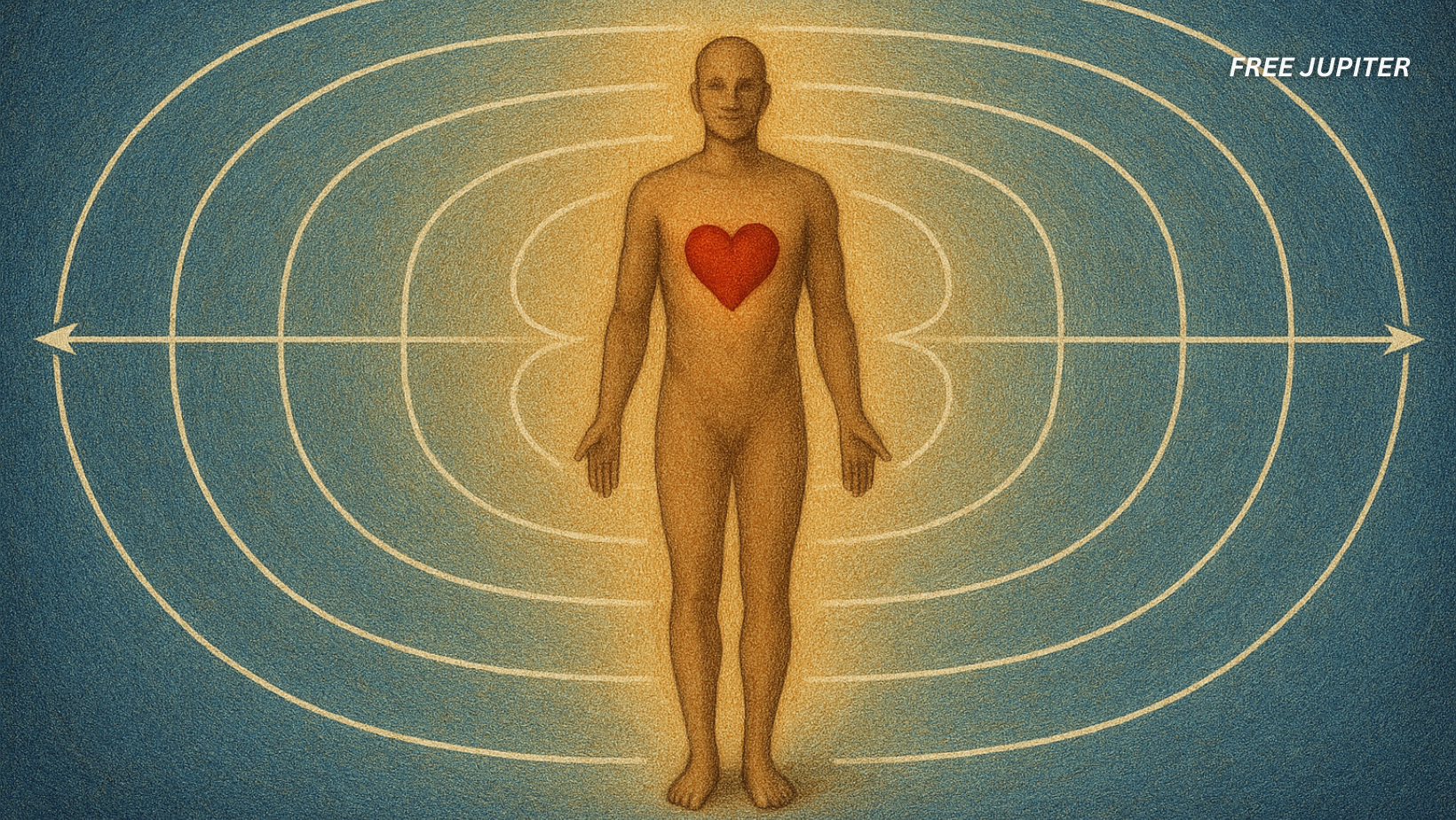Friendly Note: FreeJupiter.com shares general info for curious minds 🌟 Please fact-check all claims—and always check health matters with a professional 💙
What if your heart was more than just a pump? What if it had its own kind of intelligence—one that could sense, feel, remember, and even communicate with your brain?
As science continues to dive into the mysteries of the human body, the heart is stepping into the spotlight—not just as a physical organ, but as an emotional and energetic powerhouse.
The Heart: More Than a Pump
Yes, your heart’s main job is to keep blood flowing, making sure your body gets oxygen and nutrients while flushing out waste. But that’s not the whole story.
Scientists have discovered that the heart has around 40,000 neurons—those are the same types of nerve cells your brain uses to think, learn, and remember. That means your heart can actually learn, store information, and even feel in its own way.
This network of neurons is sometimes called the “heart-brain,” and it may play a much bigger role in your emotional and mental state than we ever imagined.
Even more surprising? The heart sends more signals to the brain than the brain sends to the heart.
Wait, The Heart Has a Magnetic Field?
Yes—and it’s a powerful one. The electrical activity of your heart creates a magnetic field that’s 100 times stronger than your brain’s. And this energy doesn’t stay locked inside your chest. It extends several feet outside your body, like an invisible force field.
This field can even be detected using scientific tools like an ECG (electrocardiogram), and some researchers suggest we might actually “feel” each other’s heart energy when we’re nearby—especially in emotionally charged or peaceful moments. Ever felt calm just being near someone? That could be your heart tuning in to theirs.
Heart and Brain: A Two-Way Street
Your brain and heart are constantly chatting, and their relationship affects how you feel, think, and respond to the world. When your emotions are all over the place—like when you’re anxious, angry, or frustrated—your heart’s rhythm becomes erratic, and your brain picks up on that chaos.
But when you’re feeling things like love, gratitude, or joy, your heart’s rhythm becomes smooth and harmonious, and your brain responds in kind. This calm, cooperative state is called coherence, and it’s linked to improved mental clarity, better decision-making, stronger emotional resilience, and even boosted creativity.
Read more: Scientists Say Cancer Can Now Be Detected Years in Advance with Simple Blood Test
Why Coherence Matters
According to researchers at the HeartMath Institute, being in a state of heart-brain coherence improves the entire body’s performance. This includes:
- Learning and problem-solving
- Reducing stress
- Staying calm under pressure
- Making smarter choices
- Emotional balance
- Creativity
- Better sleep
- Slower aging (yes, really)
When your heart and brain are in sync, your whole system runs more smoothly.
How to Get Your Heart and Brain in Sync
The good news is, just like you can train your brain to focus or learn new things, you can also train your heart to be more coherent. Here’s how to start:
- Put your attention on your heart. A simple hand on your chest can help make this connection feel real.
- Breathe intentionally. Try the 4-7-8 method: Breathe in for 4 seconds, hold for 7, exhale slowly for 8. Do this 3-4 times.
- Think of something that brings you joy. It could be a pet, a loved one, a favorite memory, or even something from your imagination.
- Amplify the feeling. Picture it as a warm light, a smile, or even a color washing over you.
- Send the feeling from your heart to your brain. Imagine this emotional “signal” flowing through your body and lighting up your cells.
Even just a minute or two of this practice can help reset your emotional state and bring you back to balance.
The Ripple Effect: How Your Energy Affects Others
When your heart is in a coherent state, you become like a tuning fork. Other people around you—especially those who are feeling off-balance—can begin to sync up with your calm energy. You might not even say a word, but your presence can help lift the mood of a room, soothe tension, or inspire trust.
That’s not just poetic—it’s physiological. When we feel safe and seen, our bodies release oxytocin, the “feel-good” hormone that supports bonding and trust. This process starts with the heart.
Read more: Scientists Reveal What That Pleasant Smell Really Is After It Rains
Real-World Uses: Heart Coherence in Action
Heart coherence isn’t just for meditation lovers or mindfulness junkies. It’s being used in medicine, law enforcement, education, and even corporate settings. For example:
- Doctors who are trained in heart coherence can more intuitively pick up on what their patients are really feeling—even if they aren’t saying it out loud.
- A calm, coherent doctor can actually help a patient feel safer and more open, just by being present.
- Teachers, leaders, and first responders are using these techniques to stay grounded and make better decisions in high-pressure moments.
Can Negative Energy Affect You?
We’ve all been around someone whose energy just feels… off. But if your heart is in a strong, coherent state, you’re less likely to absorb their negativity. In fact, your positive field may actually neutralize theirs. That’s the power of emotional self-regulation—turning your own heart into a kind of internal anchor, no matter what storms are around you.
Final Thought: You Are an Emotional Lighthouse
Your heart is constantly communicating—not just with your brain, but with the world around you. The more aware and intentional you are about what you’re feeling and radiating, the more you can affect your own well-being and the people in your orbit.
So the next time someone says you “light up a room,” it might not just be a compliment. It could be science.
When the Heart Speaks Louder Than Words
“Your Emotions Might Be Contagious—Here’s the Science Behind It”
Have you ever walked into a room and immediately felt the tension—or, on the flip side, felt uplifted just by someone’s warm presence? That’s not just intuition or mood; according to emerging research, it’s biology in action.
Scientists studying emotional contagion—the idea that emotions can spread from person to person—are now uncovering a physiological explanation rooted in the heart’s electromagnetic field. Just as we can pick up on someone’s tone or facial expression, our bodies may be wired to subconsciously sync with another person’s emotional and energetic state. This sync happens through what’s called entrainment, where rhythms from one system influence another. And the heart, as it turns out, is a powerful rhythm generator.
Read more: Your DNA Is Actually So Long That It Can Stretch From Earth to Pluto And Back 17 Times!
When a person is in a state of stress or emotional distress, their heart sends out incoherent, jagged patterns. Others nearby may subconsciously absorb this disharmony, leading to an uneasy or anxious feeling without understanding why. On the flip side, someone in a calm, coherent state emits a steady, harmonious energy—one that can help others regulate their own emotions without even exchanging words.
In group settings—like families, classrooms, workplaces, or even crowded events—this contagious energy amplifies. Research from the HeartMath Institute and similar centers suggests that groups can enter a collective “field” of coherence or incoherence, depending on the emotional states of the individuals within them.
It’s part of what makes great leaders magnetic, why certain teachers foster safe classrooms, and why some people can diffuse tension by simply being present.
So next time you feel a sudden emotional shift when someone enters a space, it might not be “just you.” You could be feeling their heart—literally.
Disclaimer: The information in this article is for general informational purposes only and is not medical advice. We are not doctors, and this website is run as a family hobby project. Always consult a qualified healthcare professional before making decisions about your health. Please fact-check any claims and use this content as a starting point, not a substitute for professional guidance.










